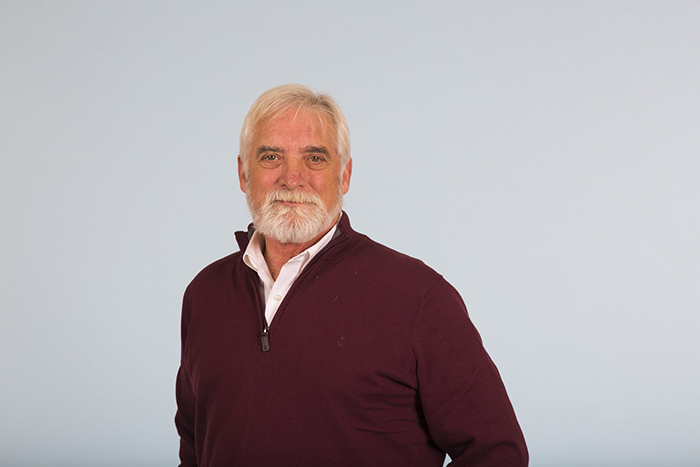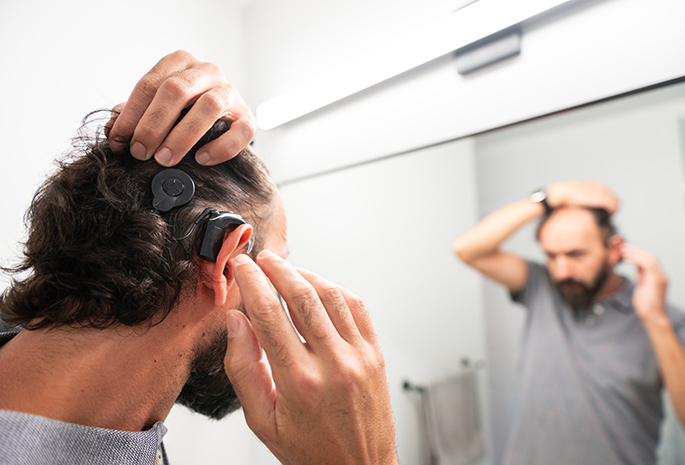Motivated To Find a Better Option
Bruce is no stranger to treatments for blocked coronary arteries. In 2014, he felt shortness of breath and chest pain when playing tennis. He went to the emergency room, where doctors diagnosed 95 percent blockages in two coronary arteries.
Doctors performed angioplasty and implanted two stents to open his arteries. Bruce quickly returned to his normal activities.
“Unfortunately, my return did not include a heart-healthy diet and weight loss program to prevent the problem from happening again,” Bruce says.
In summer 2020, Bruce kept getting short of breath during his tennis games. Tests showed blockages in his left anterior descending (LAD) artery and an adjacent artery.
A blockage in the LAD artery can shut down a large portion of heart muscle. A significant blockage in this artery is called a “widowmaker” because it can result in immediate death.
His cardiologist referred him to a cardiac surgeon where open-heart surgery was recommended.
This marked the start of Bruce’s marathon medical research project. He quickly realized he needed to be his own advocate “focused on me and my well-being. Not just the clinical aspects of surgery, but how it would impact my active lifestyle.”
“When I first read about the robotic procedure, I didn’t take it too seriously because it seemed like science fiction,” Bruce says. His local cardiac surgeon did not mention it as a treatment choice either.
During a pre-op meeting for his open-heart surgery, Bruce asked the cardiac surgeon about RA CABG. That doctor confirmed it was a viable option and that he expected to start training for the procedure in the next year or so. He suggested Bruce speak to Michael Halkos, MD, MSc, chief of cardiothoracic surgery at Emory Healthcare – a leading expert in the procedure.
The Road To Atlanta
Bruce combed through research articles and medical journals. He searched Google and watched YouTube videos of the procedure – including one produced by Dr. Halkos and his team at Emory Healthcare.
“It is time-consuming and tedious, and it requires an awful lot of thought,” Bruce says. “You also have to learn to separate objective, peer-reviewed articles from marketing material. But to get a positive outcome, it’s worth it.”
Bruce learned the ins and outs of the RA CABG procedure. He learned:
Doctors have successfully used the RA CABG procedure for thousands of cardiac bypass operations in the past 20 years.
The da Vinci robot manufactured by Intuitive Surgical was the first robotic system designed for this surgery.
Studies show CABG procedures using the da Vinci robot instead of conventional open-heart surgery give patients successful outcomes, including:
Faster recovery times
Lower risks of certain complications
Less long-term pain and discomfort
“My research made it clear to me that this was my best option,” Bruce says.
Why Emory Stood Out
Bruce began searching for the best heart surgeons and hospitals in the country that specialized in robotic-assisted CABG. After narrowing his list to four hospitals and surgeons and receiving confirmation that he was a good candidate for the minimally invasive procedure, Bruce had online video/telecon consultations with those providers.
“All of the doctors are pioneers in using the da Vinci robot and all had the same amount of experience, with more than 1,000 procedures,” Bruce says.
After the online interviews, Bruce chose Dr. Halkos to perform the RA CABG and William Nicholson, MD, Director of Complex Coronary and Cardiac Intervention at Emory Healthcare, to perform the catheter-stenting HCR procedure. Both doctors have performed more than 1,000 successful operations with positive outcomes in the past 10 years.
“What set Emory apart for me was Dr. Halkos’ bedside manner and the interest he and his staff expressed when I reached out to them,” Bruce says. “They were welcoming. They took the time to communicate with me, to discuss the procedure, expected outcomes and risks in detail. They made me feel like they really cared.”
The Recovery Process
One day after his surgery, Bruce was out of bed and walking the hospital halls. He was released on day four and walked 1.5 miles with his wife in downtown Atlanta on day five.
“With minimally invasive RA CABG, you can generally expect to get out of bed, walk and tackle stairs within days and weeks,” says Dr. Halkos. “Most patients have the breathing tube removed in the operating room, many do not require an ICU stay, and generally patients are able to go home a day or two sooner than regular bypass surgery patients.”
Two weeks after surgery, Bruce and his wife flew home to Virginia. By week five, he was back on the tennis courts.
Better Shape Than Ever
Months after his surgery, Bruce plays tennis frequently and enjoys a healthier lifestyle.
“I’m not done yet,” says Bruce. “I made big changes after this procedure. Years ago, I ignored my doctor’s recommendations to change my diet and lose weight. I thought I was invincible. This time, I decided I was given another chance and I’d better make the most of it.”
Today, after more than 20 pounds of weight loss, Bruce’s routine includes:
- Avoiding diet soda and red meat
- Daily cardiovascular exercise
- Eating a low-carb, low-sugar diet
- Getting more sleep
Recent medical tests show Bruce’s heart and arteries are in better shape than they were in 2010, he says. His cholesterol numbers are excellent because of his diet and exercise. But Bruce still wonders: if he had not stumbled upon the RA CABG procedure, and instead had open-heart surgery, would he have had as successful an outcome? While he’ll never know for sure, he is grateful for his speedy recovery and for the excellent care he received at Emory Healthcare.




